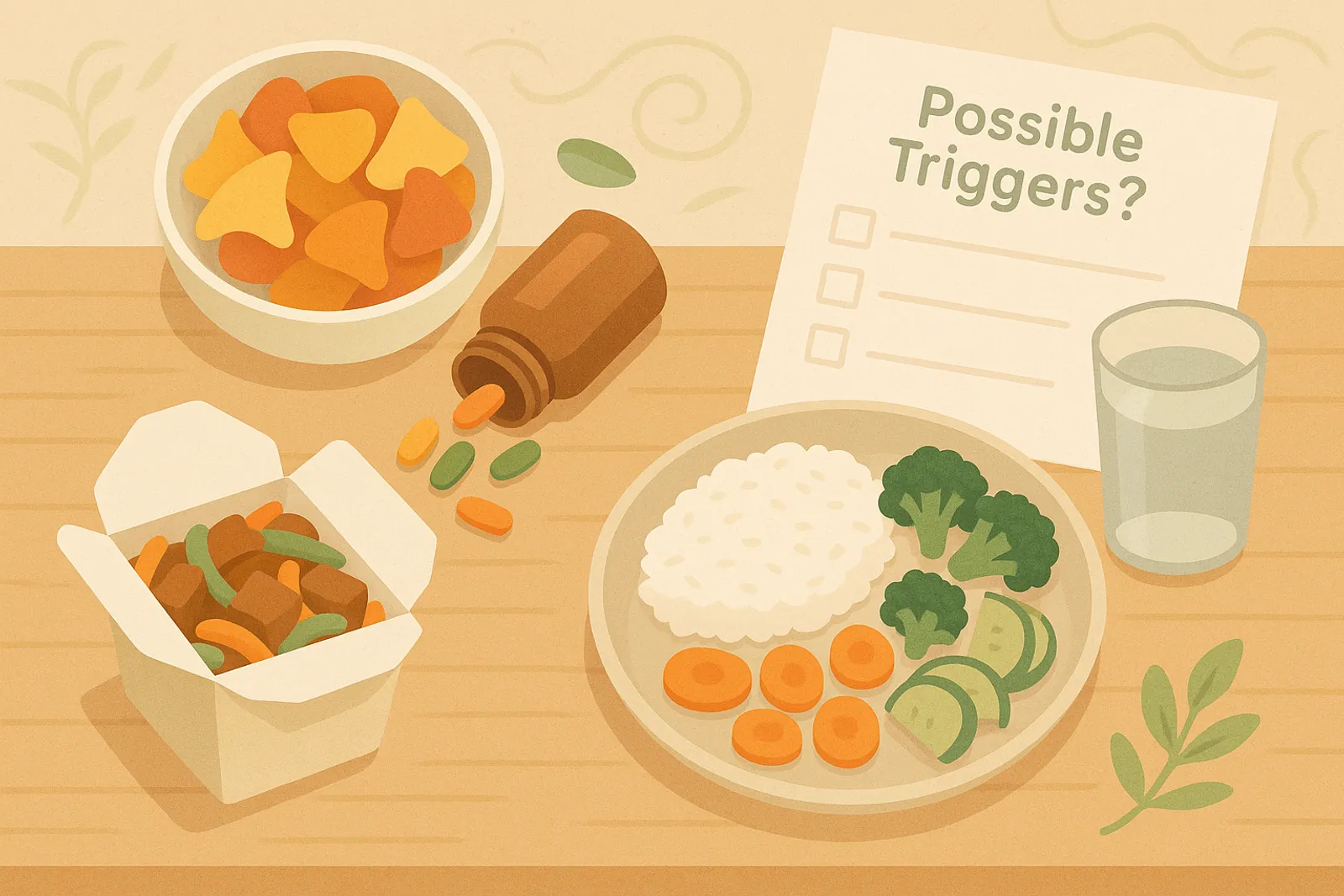Hidden CHS Triggers: Unexpected Foods That May Worsen Symptoms
Discover the surprising foods and ingredients that can trigger CHS symptoms beyond the obvious culprits. Learn about hidden additives, preservatives, and unexpected trigger foods that many people with Cannabinoid Hyperemesis Syndrome overlook.

7 min read
While most people with CHS know to avoid spicy meals and high-fat dishes, many continue experiencing symptoms despite following standard dietary advice. The reason is hidden triggers lurking in everyday foods that seem completely harmless.
These unexpected culprits can sabotage your recovery efforts and keep symptoms active even when you think you are eating safely. Understanding these hidden triggers is crucial for achieving better symptom control and faster recovery.
Food Additives and Preservatives
Artificial Sweeteners
Many sugar-free products contain artificial sweeteners that can disrupt gut microbiome balance and cause digestive symptoms in sensitive people. Research shows that compounds like saccharin, sucralose, aspartame, and acesulfame potassium may alter gut bacteria in some individuals. Multiple studies have documented changes in gut microbiota composition following artificial sweetener consumption.¹²
Common artificial sweeteners to watch:
- Aspartame (Equal, NutraSweet)
- Sucralose (Splenda)
- Acesulfame potassium
- Saccharin (Sweet’N Low)
Hidden sources:
- Diet sodas and sugar-free drinks
- Sugar-free gum and mints
- Reduced-sugar yogurts
- Protein powders and meal-replacement shakes
- Sugar-free candy and desserts
Sulfites and Sulfur Compounds
Sulfites are preservatives known to cause digestive irritation in sensitive individuals. These compounds are found in dried fruits, wine, processed meats, pickled foods, frozen potatoes, and shellfish. The FDA recognizes sulfite sensitivity as a legitimate condition that can cause gastrointestinal symptoms including nausea, vomiting, and abdominal pain in susceptible individuals. According to the FDA, sulfites can cause adverse reactions in approximately 1% of the general population.³
Monosodium Glutamate (MSG)
MSG is a widely used flavor enhancer linked to nausea, headaches, and digestive symptoms in some individuals. Though the FDA considers MSG generally safe, clinical studies have documented adverse reactions in sensitive individuals, particularly when consumed in larger quantities. Some research suggests MSG may increase visceral sensitivity in certain populations. While the FDA generally recognizes MSG as safe, clinical studies have documented adverse reactions in sensitive individuals.⁴
Hidden MSG sources:
- Hydrolyzed vegetable protein
- Autolyzed yeast extract
- Natural flavors
- Soy sauce, teriyaki sauce
- Parmesan and aged cheeses
- Tomato sauces and pastes
Unexpected Natural Triggers
Histamine-Rich Foods
High-histamine foods may worsen CHS symptoms due to inflammatory responses. These include aged cheeses, fermented foods, cured meats, leftovers, spinach, eggplant, citrus fruits, and chocolate. Histamine intolerance is a recognized condition in medical literature that can cause nausea, vomiting, and digestive distress that overlaps with CHS symptoms. This condition affects an estimated 1-3% of the population according to gastroenterology research.⁵
Salicylate-Containing Foods
Natural salicylates are plant compounds found in berries, stone fruits, herbs, nuts, honey, and certain teas. In sensitive people, salicylates may provoke GI symptoms or worsen existing digestive sensitivity. Salicylate sensitivity is documented in clinical literature and can manifest as nausea, vomiting, and abdominal pain in susceptible individuals. Natural salicylates are found in many fruits, vegetables, and herbs.
Oxalate-Rich Foods
Oxalates are compounds that can irritate the digestive system and are commonly found in foods like spinach, beets, rhubarb, nuts, sweet potatoes, dark chocolate, and tea. Oxalates are linked to inflammation and digestive irritation, which may overlap with CHS sensitivity. Oxalate-rich foods are well-documented in nephrology and gastroenterology literature.
Hidden Ingredients in Processed Foods
Carrageenan
Carrageenan, a thickener derived from seaweed, is used in many dairy and non-dairy products. Multiple peer-reviewed studies have investigated carrageenan’s potential to cause inflammation and gastrointestinal distress, particularly in people with underlying gut sensitivity. Carrageenan has been studied extensively for its potential inflammatory effects on the digestive system.⁶⁷
Common sources:
- Almond and soy milk
- Ice cream and frozen desserts
- Cream cheese and cottage cheese
- Deli meats and processed chicken
Natural Flavors
The term “natural flavors” can legally include dozens of chemical compounds, some of which may aggravate digestive issues. These ingredients appear in many flavored drinks, snacks, cereals, dressings, and supplements.
Gums and Thickeners
Food gums like xanthan gum, guar gum, and cellulose gum are used to modify texture but can cause bloating, gas, and discomfort in people with GI sensitivity. These additives are regulated by the FDA but can still cause symptoms in sensitive individuals. Research shows emulsifiers can impact gut microbiota and promote inflammation.⁸
Beverages and Hidden Triggers
Seemingly Healthy Drinks
Healthy-marketed drinks like green juice, kombucha, protein shakes, and flavored waters can contain high levels of oxalates, histamines, or artificial compounds. Herbal teas may also be high in salicylates depending on the herbs used.
Coffee and Caffeine
Caffeine can increase stomach acid and may worsen nausea or vomiting in sensitive individuals. Even decaffeinated coffee contains small amounts. Other sources include chocolate, green tea, matcha, and energy supplements (Healthline).
Cross-Contamination Issues
Shared Processing Equipment
People with CHS or other sensitivities may react to trace amounts of allergens from shared manufacturing equipment used for nuts, gluten, or spices. Supplements often contain blends of ingredients that are hard to verify.
Restaurant and Food Service
Restaurants often use seasoning mixes and marinades containing artificial additives or MSG. Oils and equipment are typically shared, and sauces may include multiple hidden ingredients.
Identifying Hidden Triggers
Detailed Food Tracking
Track all ingredients, brands, meal timing, and symptoms. Include severity, duration, and environmental factors like sleep and stress.
Elimination Protocol
Work with a provider to eliminate possible triggers:
- Begin with a basic elimination list
- Avoid suspect ingredients for 2–3 weeks
- Reintroduce foods one at a time
- Monitor symptoms
- Document reactions
Reading Labels Carefully
Look for hidden names of additives. Choose products with fewer ingredients and avoid vague terms like “natural flavors.”
Safe Food Strategies
Whole Foods Approach
Prioritize simple, minimally processed foods like fresh vegetables, plain proteins, whole grains, and homemade meals.
Trusted Brands
Look for companies with transparent practices and third-party certifications. Choose organic options where appropriate.
Preparation Methods
Use fresh foods instead of leftovers to reduce histamine levels. Cook in ways that minimize gut irritation. Avoid cross-contamination during prep.
Working with Healthcare Providers
Comprehensive Testing
Explore food sensitivity testing, histamine intolerance assessment, gut health panels, or metabolic testing.
Professional Guidance
Consult CHS-informed dietitians, gastroenterologists, or allergists for personalized support.
The Path Forward
Identifying hidden dietary triggers takes time and patience. Not every person with CHS reacts the same way. Starting small and being systematic will help you isolate problematic ingredients and reduce flare-ups.
Healing from CHS often involves improving overall health, including diet, stress, and sleep. Managing hidden food triggers is just one piece of the puzzle, but it can bring powerful relief.
TIP
Start Small
Don’t try to eliminate everything at once. Focus on one trigger category, like artificial sweeteners or sulfites. This focused approach makes it easier to see what helps and what doesn’t.
Scientific Foundation
The information in this article is based on peer-reviewed research published in medical and scientific journals, FDA guidelines on food additives, and clinical observations documented in gastroenterology literature. Key research areas include:
- Artificial Sweeteners: Studies on gut microbiota changes published in nutrition and gastroenterology journals
- Food Additive Sensitivity: Clinical research documented in allergy and immunology publications
- Histamine Intolerance: Recognized condition with established diagnostic criteria in medical literature
- MSG Sensitivity: Clinical studies published in neurogastroenterology research
- Carrageenan Effects: Toxicology and food science research on inflammatory responses
For personalized guidance, consult healthcare providers familiar with CHS and food sensitivities. Many symptoms described have established medical recognition and diagnostic protocols.
Citations
Deehan, E.C., et al. “Effect of Non‑Nutritive Sweeteners on the Gut Microbiota.” Hum Microbiome J. 2023.
Zheng Y. et al. “Differential effects of sweeteners on gut microbiome diversity and function.” Front Microbiol. 2025;16:153113.
U.S. FDA. “Sulfite sensitivity in general and asthmatic population (~1%).” FDA guidance citing ~1% prevalence.
Taros, S., et al. “Adverse reactions to monosodium glutamate: clinical studies.” Neurogastroenterol Motil. 2022.
Maintz L, Novak N. “Histamine and histamine intolerance.” Am J Clin Nutr. 2007;85(5):1185-96.
Tobacman JK. “Carrageenan and human intestinal inflammation.” J Allergy Clin Immunol. 2015;135(1):7‑49.
Komisarska P. et al. “Carrageenan as a potential factor of inflammatory bowel diseases.” Nutrients. 2024.
Chassaing B et al. “Emulsifiers impact gut microbiota, mucus barrier, and promote inflammation.” Gut. 2015.
Always consult with healthcare providers before making significant dietary changes or if you suspect food sensitivities.
Did you find this article helpful? Help us keep creating free CHS resources.
❤️ Support CHS Awareness
